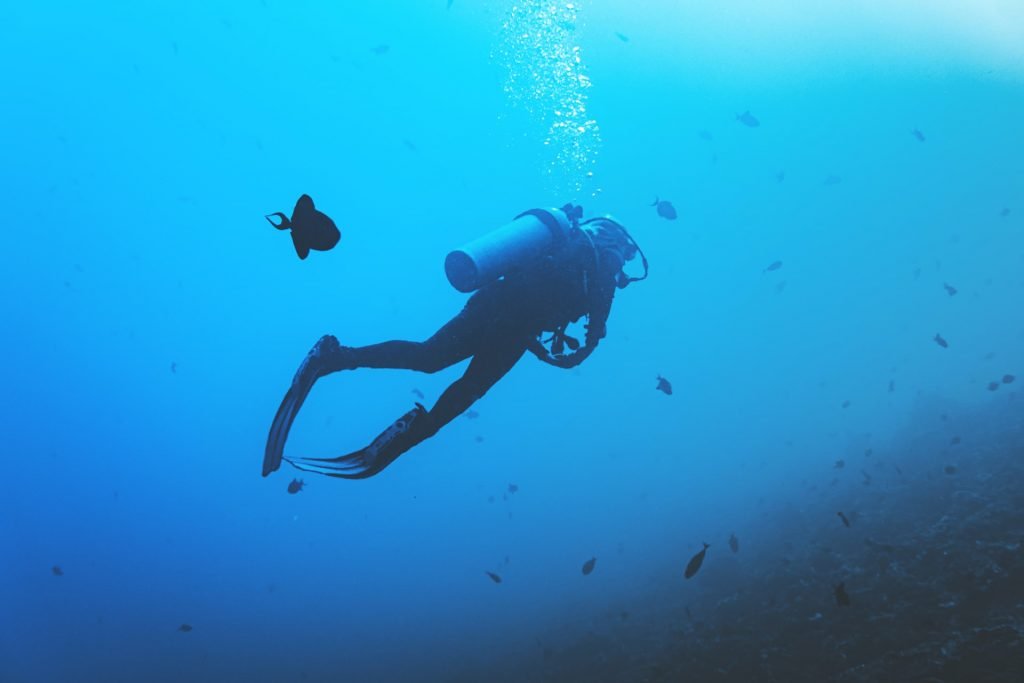
Diving Safety stops – a small habit with a big impact. From your very first open water dives, you’ll have been taught to perform a safety stop at the end of every dive. But not all divers agree with the idea of safety stops. In fact, many experienced divers omit safety stops altogether. In this instalment of our education guide series, we’re going to take a look at the safety stop, and show you why you should always perform one at the end of your dive.
What is a Diving Safety Stop and when is it required?
A safety stop is a short stop performed at the end of a recreational, no decompression dive. Unlike a decompression stop, a safety stop is not mandatory, and is instead just done for safety purposes – hence the name!
It is done to increase the conservatism of your dive. Depending on the training agency you learnt with, the safety stop is done between 3-6 metres for 3-5 minutes. Commonly, though, it’s performed for 3 minutes at 5 metres.
What is the Purpose of a Scuba Diving Safety Stop?
The purpose of a scuba diving safety stop is two fold:
Firstly, it ensures that divers slow their ascent rate, by making at least one stop before surfacing. This prevents them from ascending from their deepest depth directly to the surface at a fast rate of ascent.
Secondly, and more importantly, the safety stop allows dissolved nitrogen to off-gas from our tissues. During the dive, nitrogen accumulates in our tissues, and the longer we stay and deeper we go, the more nitrogen will dissolve into them. So by doing a safety stop before surfacing, we give the nitrogen time to leave our tissues while still under a higher ambient pressure. This allows it to come out of us at a slow, controlled rate. Then, once we surface, the overall amount of nitrogen left in our body is lower than if we had not done a safety stop. This decreases our risk of developing decompression sickness (DCS).
You can better see the effect of a safety stop with this graph:
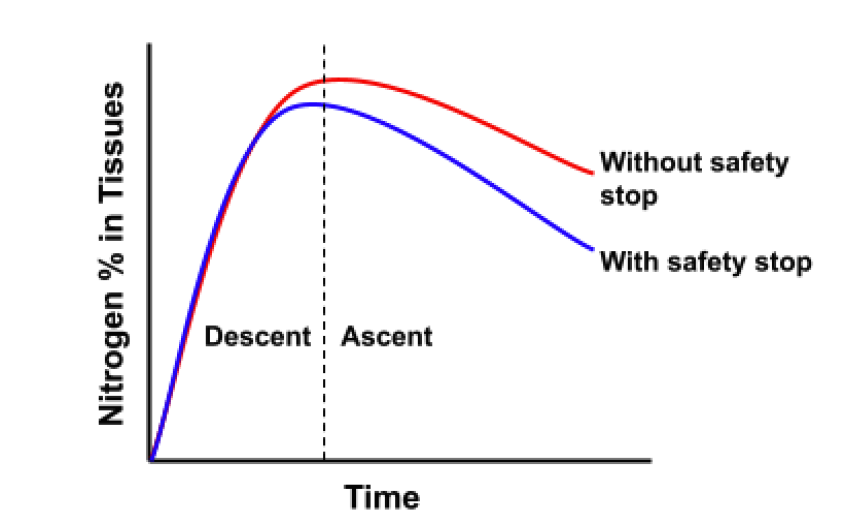
As you can see, by performing a safety stop, the amount of nitrogen dissolved in our tissues will be less when we’re back on the surface. This reduces our risk of DCS as there is less nitrogen to come out of our body and therefore a lower chance of bubbles forming and/or growing.
A Common Mistake
After divers finish their safety stop, you often see them quickly rush to the surface in a hurry. Maybe they need to pee; maybe they left something in the oven – either way, this is a bad habit which actually increases your risk of DCS. The shallower we are, the greater the difference in pressure is when we ascend.
Take a look at the table below to get an idea of this.
| Depth (Metres) | Pressure (ATA) |
| 0 | 1 |
| 10 | 2 |
| 20 | 3 |
| 30 | 4 |
| 40 | 5 |
As you can see, the pressure difference is greatest between 10 metres and the surface, being double. The deeper we go, the smaller the change is in pressure. For example, the pressure only increases by a ⅕ at 40 metres. This means that when we are shallow, we want to ascend slowly, so that the pressure is reduced gradually, allowing the nitrogen to come out of our body at a controlled rate. If we ascend too quickly the nitrogen will be forced to come out at a quicker rate, which can result in bubble formation.
Therefore, it’s key to take it slow from the end of the safety stop to the surface. In fact, some divers even go as slow as 1 metre per minute, meaning the ascent from 5 metres to the surface takes a whole five minutes. Other divers tend to go anywhere between 10-3 metres per minute.
When it comes to the final ascent, just think: The slower, the better!
Why not to do a Diving Safety Stop?
Despite the benefits of the safety stop, there are many divers – mainly experienced divers – who skip the safety stop. There are a few reasons divers may do this, some being better than others. Let’s take a closer look at these.
Firstly, one of the main reasons not to do a safety stop is if there is an emergency or some sort of threat to you. For example, if your buddy becomes unconscious during the dive and you are bringing them to the surface, then it is definitely not a good idea to delay your ascent with a safety stop.
Similarly, if your buddy is out of air, then the safest thing to do is get to the surface as quickly as possible, without exceeding a safe rate of ascent.
Secondly, if dive conditions are very bad – for example, if there’s a lot of swell or current – then performing a safety stop may also not be the best idea. This depends on dive planning, and the experience level of you and your buddy. If planned correctly, for example, you could perform a safety stop slightly deeper (at 6 metres), and deploy a DSMB as a point of reference/something to hold onto.
However, if the current or swell is so bad that it makes one of you nauseous, or puts you in danger, then it’s best to skip the safety stop and return directly to the surface.
Another reason divers skip the safety stop is simply because they don’t believe it’s worth their time and/or that it’s ineffective. This reason is clearly flawed. Firstly, it’s been proved by Divers Alert Network (DAN) in a major bubble research study, that safety stops are the most effective method of reducing post-dive bubble counts in divers, which reduces the probability of developing DCS.
Similarly, as an assessment of risk versus reward, spending an extra three minutes in the shallows at the end of the dive doesn’t seem like a huge cost considering how much safer it makes your diving.
Are there Alternatives to the Safety Stop?
If you understand diving physiology and decompression, then you’ll understand that the safety stop is not the only way of making your recreational dives safer.
As we’ve already established, the purpose of the safety stop is to slow your ascent rate to allow nitrogen to off-gas. However, this can be done without necessarily stopping at exactly 3-6 metres for 3-5 minutes.
The key to allowing nitrogen to off-gas during your ascent is to make sure your dive profile is correct. Your dive profile is simply the ‘shape’ of your dive in terms of your depth. The best dive profile is the one that is ‘healthiest’ and therefore safest for your body.
The ideal profile is one where you begin the dive at the deepest depth and then gradually ascend, getting shallower and shallower. This is known as a ‘square’ dive profile.
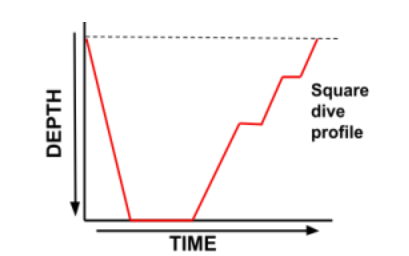
On the other hand, the worst profile is one in which you continuously descend, ascend and then re-descend. This dive profile is known as a ‘sawtooth’ profile, because of its shape.
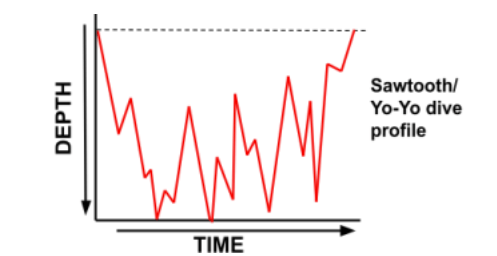
The problem with a sawtooth dive profile is that it encourages nitrogen bubbles to grow in your body, increasing the risk of DCS. Conversely, a square dive profile with a gradual, smooth ascent allows the ambient pressure to slowly reduce and for nitrogen to leave your body at a slow, continuous rate.
Therefore, if you dive a true square profile, with a smooth ascent, you will actually perform multiple safety stops, so to speak. This is because you will naturally spend a few minutes at each metre as you ascend, meaning you will do much more than a single safety stop, without ever having to formally stop and wait at the usual depth. This is also known as diving ‘on-the-fly’ and looks something like this:
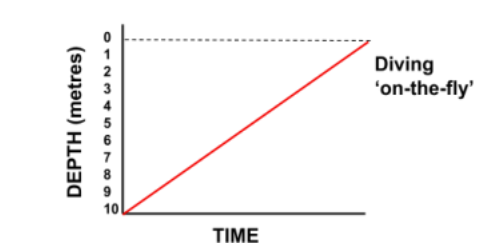
So, technically speaking, divers who dive like this are not doing a safety stop but are actually doing more than a safety stop. There are also some training agencies who try and imitate this smooth ascent by making multiple shorter safety stops at different depths – for example, 2 minutes at 9, 6 & 3 metres.
However, this style of diving is not always possible. If you’re diving on a deeper wreck, for example, with a line for the ascent and descent, then you won’t be able to do your stop(s) on the fly – instead, you’ll have to ascend, stop and wait. But, for sites with walls, coral gardens and shallow reefs, this style of diving is a great way to improve the safety and enjoyment of your dives.
What to do during your Safety Stop?
If all you do is stop and wait during your safety stop, then you’re missing out. The safety stop is a great place to practice and hone your skills. Here are just a few of the things you could try:
● Maintaining neutral buoyancy and trim, without holding onto the boat line
● An end of dive weight check (remove all the air from your BCD – you should be able to hold the stop easily)
● Mask removal and replace while neutrally buoyant, using your buddy or the boat line as a visual reference point
● Prepare your equipment for exiting the water
By doing these things at the end of every dive, you’ll take your dive skills to the next level, making them second nature.
Overall, the safety stop is a key part of your dive which only goes to make it safer. And anyway – what’s three extra minutes in the place you so love? If you enjoyed reading this piece, then check out the rest of our articles in this series for more training and dive advice articles.